

Taekwondo. Taekwondo /ˌtaɪˌkwɒnˈdoʊ/ or /ˌteɪˌkwɒnˈdoʊ/ (Korean 태권도 (hangul) / 跆拳道 (hanja), [tʰɛk͈wʌndo]) is a Korean martial art.
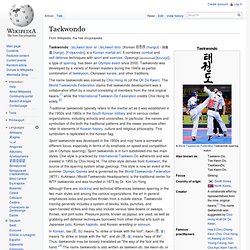
It combines combat and self-defense techniques with sport and exercise. Gyeorugi (pronounced [kjʌɾuɡi]), a type of sparring, has been an Olympic event since 2000. Tang Soo Do. Subak. Taekkyeon. Taekkyeon is the traditional military Korean martial art from the Joseon Dynasty with a dance-like appearance in some aspects.

Taekkyeon is also frequently romanized informally as Taekgyeon, Taekkyon, or Taekyun. History of Taekkyeon[edit] The earliest existing written source mentioning Taekkyeon is from the time of King Jeongjo, who reigned Korea from 1776 to 1800. During this time, the book Jaemulbo (also Manmulbo) was written by Lee, Sung-Ji.[1] The text says Byeon and Subak are Byeon, Gangnyeok is Mu and all these are called Tak-gyeon [sic!] This means that Taekkyeon might derive from an earlier art called Subak. It cannot be said for sure when and how taekkyon came into existence, but until the end of the Korean kingdom, certain people did taekkyon together.
Subak. Shippalgi. Sib Pal Gi (or Sib Pal Ki, Korean 십팔기, 十八技 "Eighteen Medthods", or 十八般武艺 "Eighteen Fighting Methods", shortened from Bonjo Muye Sib Pal Ban 본조무예십팔반, 文章武藝十八般, "18 Martial Arts Classes of the Yi Dynasty") may refer to:
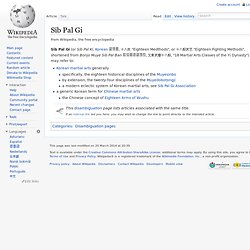
Kumdo. Kumdo is a modern Korean martial art originating from Japanese Kendo.
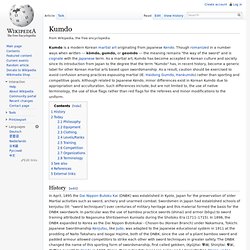
Though romanized in a number ways when written --- kǒmdo, gumdo, or geomdo --- the meaning remains "the way of the sword" and is cognate with the Japanese term. As a martial art, Kumdo has become accepted in Korean culture and society since its introduction from Japan to the degree that the term "Kumdo" has, in recent history, become a generic label for other Korean martial arts based upon swordsmanship. As a result, caution should be exercised to avoid confusion among practices espousing martial (IE. Haidong Gumdo, Hankumdo) rather than sporting and competitive goals. Although related to Japanese Kendo, minor differences exist in Korean Kumdo due to appropriation and acculturation.
Kuk Sul Do. Kuk Sul is a Korean martial arts style that was brought to the United States by Choon S.

Yang. The name "Kuk Sul Do" translates to "National Korean Martial Art", and was put together from a number of different Korean martial art styles in order to preserve traditions and movements that are thousands of years old. Because of Kuk Sul Do's beginning, it is a well-rounded traditional style that doesn't necessarily have any specific weaknesses, and encompasses a large amount of material and tradition. Kuk Sool Won. Overview[edit] The study of Kuk Sool Won includes many modern day techniques such as gun defense and weapon improvisation.

Kuk Sool Won has many facets and is performed for self-defense, healing, conditioning, competition, fun and aesthetic purposes. Characteristics[edit] Kuk Sool Won encompasses many different traditional Korean "arts". However, it still has some discernible characteristics that set it apart from other traditional martial arts. Student creed[edit] Kuk Sool Won students are all expected to abide by the Kuk Sool Won Pledge[7] I pledge to obey the rules of the association and to conduct myself in accordance with the true spirit of martial arts.I pledge to be loyal to my country and to promote the development of a better society.I pledge to work together with all classes of people without regard to politics, race or religion.I pledge to promote international goodwill and to strive for world peace through the practice of martial arts.
Hwa Rang Do. Hwa Rang Do is a Korean martial art that was created by Joo Bang Lee and his brother Joo Sang Lee.
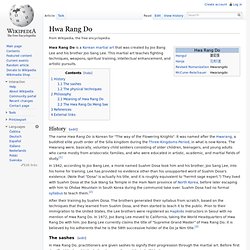
This martial art teaches fighting techniques, weapons, spiritual training, intellectual enhancement, and artistic pursuits. History[edit] The name Hwa Rang Do is Korean for "The way of the Flowering Knights". It was named after the Hwarang, a buddhist elite youth order of the Silla kingdom during the Three-Kingdoms Period, in what is now Korea. Hapkido. The art adapted from Daitō-ryū Aiki-jūjutsu (大東流合気柔術) as it was taught by Choi Yong-Sool (Hangul: 최용술) when he returned to Korea after World War II, having lived in Japan for 30 years.
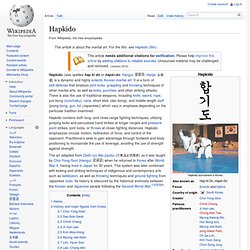
This system was later combined with kicking and striking techniques of indigenous and contemporary arts such as taekkyeon, as well as throwing techniques and ground fighting from Japanese Judo. Its history is obscured by the historical animosity between the Korean and Japanese people following the Second World War.[1][2][3][4] Name[edit] Hapkido is rendered "합기도" in the native Korean writing system known as hangul, the script used most widely in modern Korea.
The art's name can also however be written "合氣道" utilizing the same traditional Chinese characters which would have been used to refer to the Japanese martial art of aikido in the pre-1946 period. Although aikido and hapkido are believed by many to share a common history, they remain separate and distinct from one another. Hankido. Hankido is a new martial art style developed by Myung Jae-nam using even more circular flowing movements owing to Myung Jae-nam's background in traditional Korean dance.

Etymology[edit] The name hankido is a mix of the name Hanguk (the Korean name for South Korea) and hapkido. Han Mu Do. Han Mu Do, founded by Dr.
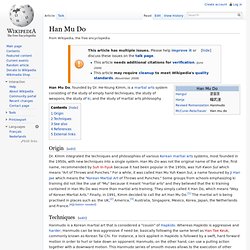
He-Young Kimm, is a martial arts system consisting of the study of empty hand techniques, the study of weapons, the study of ki, and the study of martial arts philosophy. Origin[edit] Dr. Haidong Gumdo. Haidong Gumdo (Haedong Gumdo, 海東劍道 "Korean way of the sword") arose in April of 1983 as the Hai Dong Gumdo Association with its main office in Seocho-gu, Seoul and, in November, 1996 was incorporated as the World Hai Dong Gumdo Federation (WHDGF). In promoting his art, KIM Jeong-ho reported that in 1962 he began training with his master, a monk called Jang Paek-san, and opened the first "Way of the Eastern Sea" ("Hai Dong Kumdo") training hall in Anyang, Kyungki province, in July of 1982. To the degree that Hae Dong Kumdo draws on material gleaned from Bon Kuk Geom Beop, it could qualify as a type of historical martial arts reconstruction.
While the purist may take exception to the selection of sword architecture to execute a given method, the theatrical or gymnastic qualities of practice and the inconsistent representation of provenance for this practice, its growing popularity has made it a staple of the Korean Martial Art community. Gyongdang. The Korean term Gyongdang or Gyeongdang (敬堂 "royal hall") may refer to: Gwonbeop. Kwonbeop is the term for unarmed methods in Korean martial arts as developed in the Joseon era (15th to 19th centuries). It is the Korean rendition of the Chinese Quan fa (拳法). Early development[edit] GongKwon Yusul. Gongkwon Yusul is a modern Korean martial art system founded by Kang Jun in 1996. Choi Kwang-Do. Choi Kwang Do is a martial art developed by Kwang Jo Choi.